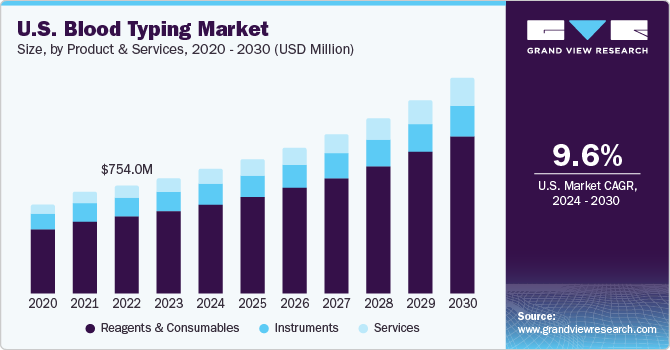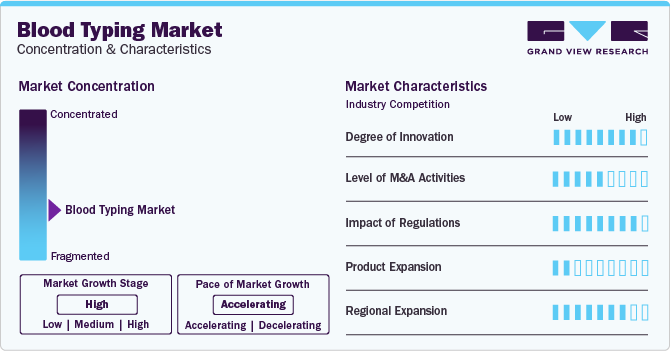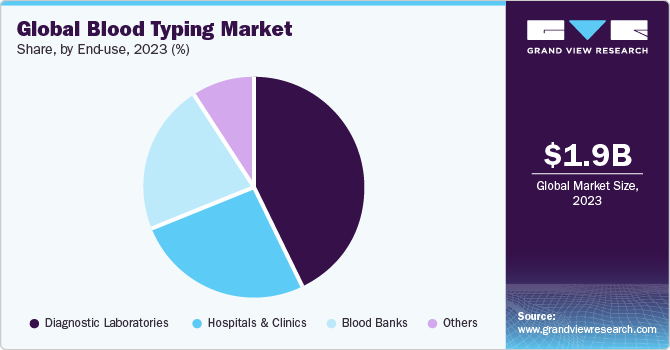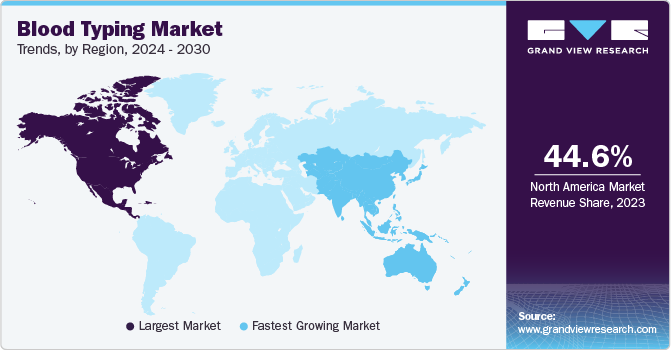- Home
- »
- Clinical Diagnostics
- »
-
Blood Typing Market Size, Share & Growth Report, 2030GVR Report cover
![Blood Typing Market Size, Share & Trends Report]()
Blood Typing Market Size, Share & Trends Analysis Report By Product & Services (Instruments, Reagents & Consumables), By Test Type (Antibody Screening, HLA Typing), By Technique, By Application, By End-use, By Region, And Segment Forecasts, 2024 - 2030
- Report ID: GVR-4-68040-263-1
- Number of Report Pages: 125
- Format: PDF, Horizon Databook
- Historical Range: 2018 - 2022
- Forecast Period: 2024 - 2030
- Industry: Healthcare
Blood Typing Market Size & Trends
The global blood typing market size was estimated at USD 1.97 billion in 2023 and is projected to grow at a CAGR of 10.3% from 2024 to 2030. The market is driven by the increasing prevalence of chronic diseases, the rising number of surgical procedures, and the growing incidence of road accidents and trauma cases, which necessitate transfusions. These factors highlight the essential role of blood group typing in simplifying efficient transfusions. The market is also influenced by advancements in technology and the high usage of blood group typing in forensic sciences and prenatal testing. Moreover, AN increase in blood donations and transplant procedures is further propelling the market growth.

The increasing prevalence of surgeries and rising demand for blood and related components are significant factors contributing to the market expansion. Surgeries, in particular, often necessitate significant amounts of blood for safe and successful outcomes, leading to an increased number of donations and transfusions. The American National Red Cross reported that approximately 29,000 units of RBCs are required every day in the U.S., highlighting the critical role of blood donations in supporting patients undergoing complex surgical procedures. The demand for blood group typing is expected to grow, as it is driven by the need for accurate blood group testing in organ transplantation and high demand for transfusions in emergencies and chronic disease management.
In addition, the rise in road accidents and trauma cases significantly contributes to the market growth. According to the WHO, around 1.19 million people die each year in road traffic accidents globally. This statistic highlights the critical role of transfusions in emergencies, directly impacting the demand for blood group typing. The increased frequency of road accidents necessitates the availability of blood banks to be easily accessible, creating a strong market driver. Coupled with the advanced medical infrastructure in various countries, which has increased the storage capacity of many hospitals, indicates growing industry opportunities.
Increasing demand for transfusions and organ transplantations significantly contributes to the market expansion. According to WHO, the most often transfused patient group is over 60 years of age, accounting for up to 76% of all transfusions. In contrast, in low-income countries, up to 54% of transfusions are for children under 5 years of age. This indicates a growing need for transfusions across different age groups and regions. In addition, the increase in voluntary unpaid blood donations from 2008 to 2018, with 10.7 million donations reported, suggests a growing supply of blood, which could potentially meet the increasing demand. Organ transplantation, in particular, is a life-saving procedure for individuals with end-stage organ failure, requiring a compatible match between the donor and recipient, which includes blood group compatibility. According to the United Network of Organ Sharing, more than 42,800 organ transplants were performed in the US in 2022, indicating a growing demand for blood group typing products and services.
Market Concentration & Characteristics
The degree of innovation is high. The market is characterized by the continuous development and adoption of advanced technologies that enhance the speed, accuracy, and efficiency of blood group typing processes. This innovation is driven by the increasing demand for transfusions and organ transplantations, as well as the rising incidence of road accidents and trauma cases that necessitate immediate transfusions.

The level of M&A activities in the market is relatively low. This can be attributed to several factors, including the specialized nature of the industry, presence of well-established key players, and focus on innovation and product development rather than consolidation through acquisitions.
Regulations for blood group testing products and services are strict, ensuring safety and accuracy of transfusions and organ transplantations. The strict regulations impact the market by setting high standards for product development and testing, which can drive innovation and investment in the industry. However, it also poses challenges for market entry and expansion, as companies must navigate complex approval processes and adhere to stringent safety and quality standards. The regulatory environment, characterized by a focus on safety, accuracy, and quality, significantly influences industry dynamics, including product development, pricing, and industry growth.
The product expansion is generally moderate for the market. Some of the players are focusing on new product launches to cater to the growing demand. For instance, in February 2022, InTec launched the 2nd generation ABO & RhD Blood Grouping Kit. This launch is likely to help the company gain a larger customer base.
Regional expansion in the market is primarily focused on reaching out to hospitals and blood banks in various countries, with these entities being the primary consumers of blood typing products and services. Hospitals, due to their extensive use of blood typing for patient care, including emergency situations, surgeries, and organ transplantations, represent a significant portion of the sector. Blood banks, on the other hand, rely heavily on accurate blood typing to ensure safe and effective transfusions. Other end-users, such as clinical laboratories and specialized testing facilities, also contribute to the sector but are less concentrated compared to hospitals and blood banks.
Product & Services Insights
The reagents and consumables segment led the market with the largest revenue share of 71.7% in 2023 and is anticipated to grow at a lucrative CAGR over the forecast period. The recurring cost associated with frequent requirement of reagents & kits is a significant factor contributing to the market's growth. This constant need for consumables is driven by the high frequency of blood typing tests in various clinical settings, including hospitals, clinical laboratories, and blood banks. Technological advancements continuously drive the development of new and improved reagents, enhancing the accuracy and efficiency of blood typing processes.
The services segment is anticipated to grow at a significant CAGR over the forecast period. The increasing demand for transfusions and organ transplantations, rise in surgical operations, and growing use of reagents and serological fluids in laboratories. The elevated donation rates, which result in more blood sample analysis, also contribute to the expansion of the services segment. The importance of blood group analysis is projected to rise as the trend of donation out of societal concern increases, further driving the demand for services related to blood group testing.
Test Type Insights
Based on test type, the antibody screening segment led the market with the largest revenue share of 38.6% in 2023, due to the growing volume of prenatal testing, increasing transfusions, and rising prevalence of chronic diseases. Pregnant patients require various screening tests, including blood group and antibody screening, increasing the segment growth. According to a study published in the Journal of Personalized Medicine in April 2023, between 2012 and 2022, there were 51,803 new genetic tests introduced to the market in the U.S., with a significant portion of these being diagnostic tests, which are fundamental for prenatal screening. This indicates a substantial volume of prenatal testing, including blood group and antibody screening, contributing to market growth.
The HLA typing segment is anticipated to grow at the fastest CAGR over the forecast period. The number of individuals on the national transplant waiting list, which stands at 103,223 significantly contributes to this growth. Transplants require HLA typing to ensure compatibility between donor and recipient, crucial for preventing graft rejection and ensuring transplant success. HLA typing allows for more precise matching between donors and transplant patients, reducing the incidence and severity of graft-versus-host disease (GvHD) and increasing long-term survival. The rise in autoimmune diseases and cancers has also increased the demand for HLA typing, as these conditions often involve the immune system attacking the body's cells.
Technique Insights
Based on technique, the PCR-based and microarray-based segment led the market with the largest revenue share of 52.4% in 2023. The adoption of automated blood typing technologies, including PCR-based and microarray techniques, has improved the speed, standardization, and safety of transfusion diagnostics. A team from Tokyo University of Science has developed a technologically advanced lab-on-a-chip device that can determine a person’s blood type within five minutes, significantly speeding up the process of transfusion in emergency situations. These technologies offer advantages over manual typing, including cost efficiency, increased efficiency, and reduced errors highlighting the market's shift towards automated and high-throughput solutions.
The assay-based techniques segment is expected to grow at a significant CAGR during the forecast period. These techniques, including slide methods, test-tube methods, microplate methods, and gel/column centrifugation, are commonly used in hospitals and blood banks for general blood typing due to their convenience. As technologies continue to evolve, the efficiency and accuracy of these methods contribute significantly to the safety and success of transfusions and transplantation procedures. Increasing requirement for blood during surgical treatments and a growing number of hospitals further fuel the demand for accurate and swift blood group testing procedures, highlighting the essential role of assay-based techniques in the market.
Application Insights
Based on application, the diagnostic testing segment led the market with the largest revenue share of 54.1% in 2023. The adoption of automated blood analysis technologies, such as PCR-based and microarray techniques, which improves diagnostic speed, standardization, and safety. These technologies offer cost, efficiency, and error reduction benefits, making them attractive for healthcare institutions. The development of lab-on-a-chip devices for rapid blood type determination further enhances diagnostic testing's appeal. This growth is supported by the need for various screening tests during pregnancy, including blood group and antibody screening.
The organ transplants segment is anticipated to grow at the fastest CAGR over the forecast period. Technological advancements, such as the introduction of molecular diagnostics methods such as NGS and PCR, have made organ transplantation more feasible and safer, thereby increasing the market's growth. In addition, the rising incidence of infectious diseases and the aging population contribute to the need for organ transplants, further driving the demand for blood group testing services. The industry growth is also supported by strategic collaborations among firms, which accelerate product innovation and market expansion.
End-use Insights
Based on end-use, the diagnostic laboratories segment led the market with the largest revenue share of 43.4% in 2023. The rising prevalence of chronic diseases and traumatic injuries, necessitates increased transfusions and organ transplantations. This demand is fueled by the development of advanced blood typing technologies, enhancing accuracy, speed, and efficiency. In addition, growing awareness of the importance of blood typing for safe transfusions and transplantations, coupled with investments in healthcare infrastructure, particularly in emerging economies, drives the demand for blood typing products and services. Government policies and initiatives aimed at improving healthcare access and infrastructure further contribute to market growth.

The blood banks segment is anticipated to grow at the fastest CAGR during the forecast period, driven by several key factors and drivers. The primary reason for this growth is the increasing demand for transfusions and organ transplantations, which necessitate blood typing to ensure compatibility between donors and recipients. This demand is fueled by a combination of factors including the rise in major surgical procedures, the volume of donations, and the growing prevalence of chronic diseases and blood disorders. Furthermore, the establishment of large blood banks and donation campaigns to ensure a constant supply of blood contributes to the market's growth. These initiatives are crucial in meeting the high demand for transfusions and organ transplantations, which in turn drives the need for blood typing services.
Regional Insights
North America dominated the blood typing market with a revenue share of 44.6% in 2023, owing to factors such as the region's well-developed healthcare infrastructure and a large number of transfusions happening in the region. Major companies operating in the blood group typing sector, such as Bio-Rad Laboratories, Inc., QuidelOrtho Corporation, and Thermo Fisher Scientific Inc., have significant expertise, resources, and established distribution networks. The companies' comprehensive product portfolios, expansive global footprint, and well-established brand recognition further support region dominance. Additionally, the high burden of chronic conditions on regional healthcare systems is a major driver for market growth, necessitating the need for donations and, consequently, blood typing services
U.S. Blood Typing Market Trends
The blood typing market in the U.S. is expected to grow at the fastest CAGR over the forecast period, due to frequent approvals and novel diagnostics launches aided by the increasing investment in advancement of diagnostic solutions.
Europe Blood Typing Market Trends
The blood typing market in Europe was identified as a lucrative region in this industry. The market growth in the region can be attributed to rising chronic diseases aided by an increase in research funding and the local presence of key market players in this region.
The UK blood typing market is expected to grow at the fastest CAGR over the forecast period, due to the presence of well-established healthcare infrastructure, high disposable income and rising awareness about early disease diagnosis.
The blood typing market in France is expected to grow at the fastest CAGR over the forecast period, attributed to increasing demand for blood group typing in prenatal testing in the country.
The Germany blood typing market is expected to grow at the fastest CAGR over the forecast period, due to the rising number of initiatives veing taken by government to help spread awareness regarding diagnosis and innovative diagnostic solutions.

Asia Pacific Blood Typing Market Trends
The blood typing market in Asia Pacific is anticipated to witness at the fastest CAGR over the forecast period. The increasing number of donation activities and the rising incidence of trauma, accidents, and surgeries requiring transfusion are key drivers. In addition, the growing demand for blood group typing in prenatal and postnatal testing, along with the stringency of prudent transfusions, is expected to boost the market growth. Technological advancements in healthcare, such as new molecular diagnostic tools, facilitate rapid and reliable group identification, providing opportunities for market growth.
The China blood typing market is expected to grow at the fastest CAGR over the forecast period, due to the growing focus on improving healthcare R&D aided with development of novel technologies.
The blood typing market in Japan is expected to grow at the fastest CAGR over the forecast period, due to the presence of well-established healthcare system and high adoption of advanced diagnosis tests & therapies for effective diagnosis & management of target diseases.
Latin America Blood Typing Market Trends
The blood typing market in Latin America was identified as a lucrative region in this industry. Technological advancements and the increasing demand for transfusions in the region, are anticipated to fuel market growth.
The Brazil blood typing market is expected to grow at the fastest CAGR over the forecast period, due to the rising prevalence of chronic diseases and the technological advancement.
Middle East & Africa Blood Typing Market Trends
The blood typing market in Middle East & Africa was identified as a lucrative region in this industry. The market in this region is driven by the high prevalence of chronic diseases, aided with improvements in healthcare infrastructure.
The Saudi Arabia blood typing market is expected to grow at the fastest CAGR over the forecast period, owing to the need for better diagnostics and improvements in treatment options due to the rising prevalence of chronic diseases.
Key Blood Typing Company Insights
Some of the leading players operating in the global market include Siemens Healthineers AG, Abbott, and Beckman Coulter, Inc. Key players are using existing customer bases in the region to prioritize maintaining high-quality standards and gain high market size access. This strategy is useful for brands that have already built trust in the market. These players are heavily investing in advanced technology and infrastructure, allowing them to process & analyze a large volume of samples efficiently. Moreover, companies undertake various strategic initiatives with other companies and distributors to strengthen their market presence.
Randox Laboratories, Creative Diagnostics, and Life Diagnostics are some of the emerging participants in the market. These companies focus on achieving funding support from government bodies and healthcare organizations aided with novel product launches to capitalize on untapped avenues.
Key Blood Typing Companies:
The following are the leading companies in the blood typing market. These companies collectively hold the largest market share and dictate industry trends.
- Mesa Laboratories, Inc. (Agena Bioscience, Inc.)
- Danaher Corporation (Beckman Coulter)
- Bio-Rad Laboratories, Inc.
- DIAGAST
- Grifols, S.A.
- AXO Science
- Merck KGaA
- Quotient, Ltd.
- Thermo Fisher Scientific
- Immucor, Inc.
- BAG Diagnostics GmbH
- Seegene Inc.
Recent Developments
-
In June 2023, Alba by Quotient expanded into Netherlands and Sweden, joining existing European markets. Offering high-quality blood bank reagents, expert support, and reliable service. Quotient, with over 30 years of experience, also provides MosaiQ solution for advanced diagnostics
-
In May 2023, Bio-Rad launched IH-500 NEXT, a fully automated system for ID-Cards, enhancing immunohematology lab efficiency with optimized result interpretation and cybersecurity. Offers flexibility with Bio-Rad or third-party reagents
-
In March 2023, Werfen completed the acquisition of Immucor, Inc. for approximately USD 2 billion, expanding its Specialized Diagnostics portfolio in Transfusion and Transplant markets
Blood Typing Market Report Scope
Report Attribute
Details
Market size value in 2024
USD 2.13 billion
Revenue forecast in 2030
USD 3.83 billion
Growth rate
CAGR of 10.3% from 2024 to 2030
Base year for estimation
2023
Historical data
2018 - 2022
Forecast period
2024 - 2030
Quantitative units
Revenue in USD million/billion and CAGR from 2024 to 2030
Report coverage
Revenue forecast, company ranking, competitive landscape, growth factors, and trends
Segments covered
Product & services, test type, technique, application, end-use, region
Regional scope
North America; Europe; Asia Pacific; Latin America; Middle East & Africa
Country scope
U.S.; Canada; Germany; UK; France; Italy; Spain; Denmark; Sweden; Norway; China; Japan; India; South Korea; Australia; Thailand; Brazil; Mexico; Argentina; South Africa; UAE; Kuwait; Saudi Arabia
Key companies profiled
Mesa Laboratories, Inc.; (Agena Bioscience, Inc.); Danaher Corporation (Beckman Coulter); Bio-Rad Laboratories, Inc.; DIAGAST; Grifols; S.A.; AXO Science; Merck KGaA; Quotient, Ltd.; Thermo Fisher Scientific; Immucor, Inc.; BAG Diagnostics GmbH; Seegene Inc.
Customization scope
Free report customization (equivalent up to 8 analyst’s working days) with purchase. Addition or alteration to country, regional & segment scope.
Pricing and purchase options
Avail customized purchase options to meet your exact research needs. Explore purchase options
Global Blood Typing Market Report Segmentation
This report forecasts revenue growth at global, regional, and country levels and provides an analysis of the latest industry trends in each of the sub-segments from 2018 to 2030. For this study, Grand View Research has segmented the global blood typing market report based on product & services, test type, technique, application, end-use, and region:
-
Product & Services Outlook (Revenue, USD Million, 2018 - 2030)
-
Instruments
-
Reagents & Consumables
-
RBC Reagents
-
Antisera Reagents
-
Anti-Human Globulin Reagents
-
Blood Saline Reagents
-
-
Services
-
-
Test Type Outlook (Revenue, USD Million, 2018 - 2030)
-
Antibody Screening
-
HLA Typing
-
Cross-matching
-
ABO Blood Tests
-
Others
-
-
Technique Outlook (Revenue, USD Million, 2018 - 2030)
-
PCR Based and Microarray Based
-
Assay Based Technique
-
Massively Parallel Sequencing
-
Other
-
-
Application Outlook (Revenue, USD Million, 2018 - 2030)
-
Blood Transfusions
-
Organ Transplants
-
Diagnostic Testing
-
-
End-use Outlook (Revenue, USD Million, 2018 - 2030)
-
Hospitals & Clinics
-
Diagnostic Laboratories
-
Blood Banks
-
Others
-
-
Regional Outlook (Revenue, USD Million, 2018 - 2030)
-
North America
-
U.S.
-
Canada
-
-
Europe
-
Germany
-
UK
-
France
-
Italy
-
Spain
-
Denmark
-
Sweden
-
Norway
-
-
Asia Pacific
-
China
-
Japan
-
India
-
South Korea
-
Australia
-
Thailand
-
-
Latin America
-
Brazil
-
Mexico
-
Argentina
-
-
Middle East and Africa (MEA)
-
South Africa
-
Saudi Arabia
-
Kuwait
-
UAE
-
-
Frequently Asked Questions About This Report
b. The global blood typing market size was estimated at USD 1.97 billion in 2023 and is expected to reach USD 2.12 billion in 2024.
b. The global blood typing market is expected to grow at a compound annual growth rate of 10.3% from 2024 to 2030 to reach USD 3.83 billion by 2030.
b. North America dominated the blood typing market with a share of 44.6% in 2023. This is attributable to the large number of blood donation drives and high awareness levels of blood typing
b. Some key players operating in the blood typing market include Mesa Laboratories, Inc. (Agena Bioscience, Inc.), Danaher Corporation (Beckman Coulter), Bio-Rad Laboratories, Inc., DIAGAST, Grifols, S.A., AXO Science, Merck KGaA, Quotient, Ltd., Thermo Fisher Scientific Inc., Immucor, Inc., BAG Diagnostics GmbH, and Seegene Inc.
b. Key factors that are driving the market growth include Increasing demand for blood group typing in prenatal testing and Growing number of road accidents, emergencies, and trauma cases necessitating transfusions
Share this report with your colleague or friend.
![gvr icn]()
NEED A CUSTOM REPORT?
We can customize every report - free of charge - including purchasing stand-alone sections or country-level reports, as well as offer affordable discounts for start-ups & universities. Contact us now
![Certified Icon]()
We are GDPR and CCPA compliant! Your transaction & personal information is safe and secure. For more details, please read our privacy policy.
We are committed towards customer satisfaction, and quality service.
"The quality of research they have done for us has been excellent."





